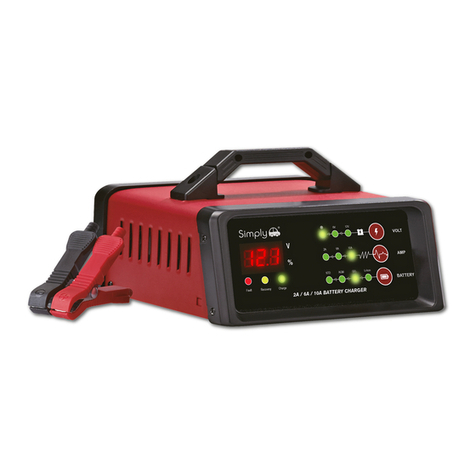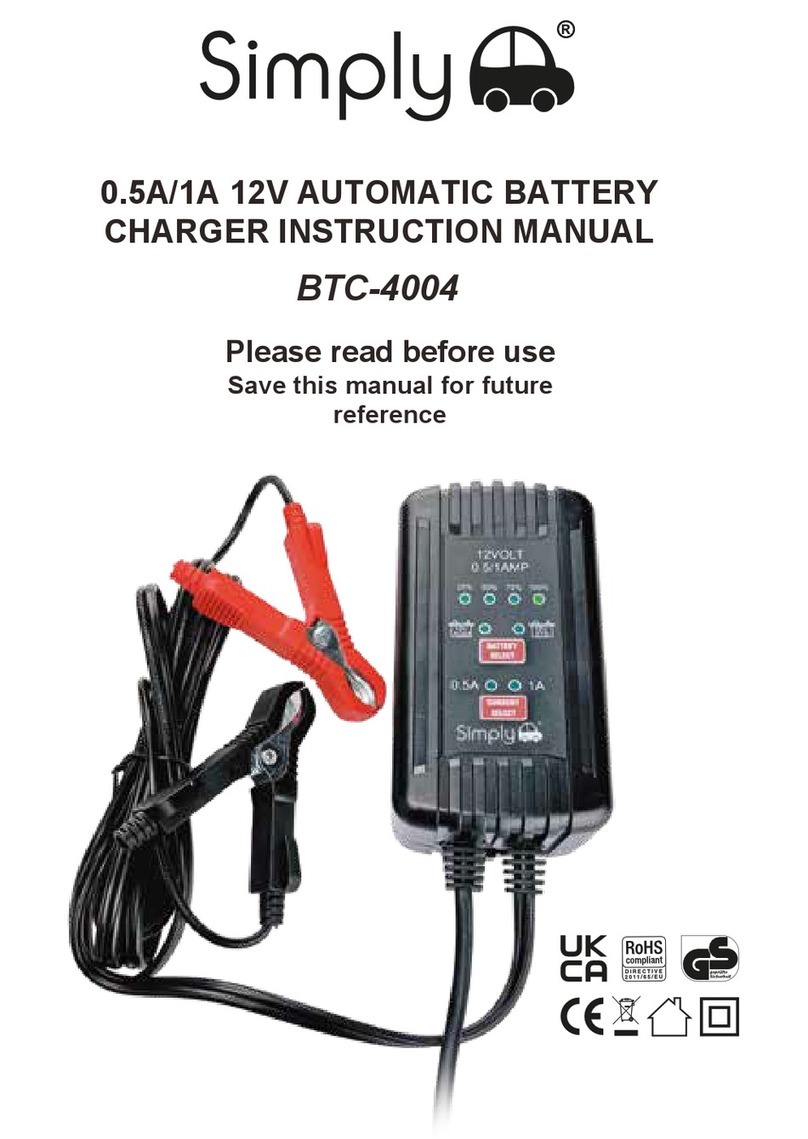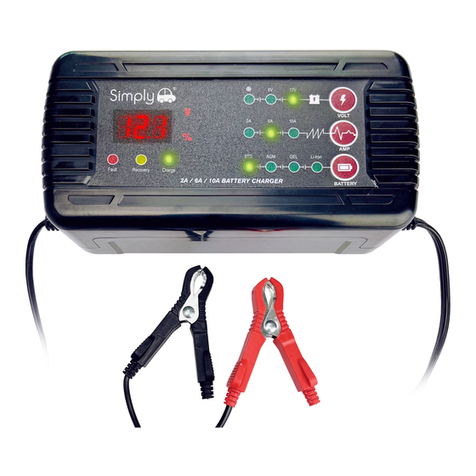Simply BTC-4005 User manual

BTC-4005
Please read before use
Save this manual for future
reference
2A/4A 6V/12V AUTOMATIC
BATTERY CHARGER INSTRUCTION MANUAL

SAFETY GUIDELINES/DEFINITIONS
• DANGER: Indicates an imminently hazardous situation which, if not avoided, will result
in death or serious injury.
• WARNING: Indicates a potentially hazardous situation which, if not avoided, could
result in death or serious injury.
• CAUTION: Indicates a potentially hazardous situation which, if not avoided, may result
in minor or moderate injury.
• CAUTION: Used without the safety alert symbol indicates potentially hazardous
situation which, if not avoided, may result in property damage.
• RISK OF UNSAFE OPERATION. When using tools or equipment, basic safety
precautions should always be followed to reduce the risk of personal injury. Improper
operation, maintenance or modification of tools or equipment could result in serious injury
and property damage. There are certain applications for which tools and equipment are
designed. Simply Auto strongly recommends that this products NOT be modified and/or
used for any application other than for which it was designed. Read and understand all
warning and operating instructions before using any tool or equipment.
IMPORTANT SAFETY INSTRUCTION
WARNING-RISK OF EXPLOSIVE GASES
WORKING IN THE VICINTY OF A LEAD-ACID BATTERY IS DANGEROUS.
BATTERIES GENERATE EXPLOSIVE GASES DURING NORMAL OPERATION.
FOR THIS REASON, IT IS IMPORTANT THAT YOU FOLLOW THESE INSTRUCTIONS
EACH TIME YOU USE THE CHARGER.
To reduce the risk of a battery explosion, follow these instructions and those published
by the manufacturers of the battery and any equipment you intend to use in the vicinity of
the battery. Review the cautionary markings on these productions and on the engine.
WARNING: Do not use battery charger with dry cell batteries that are commonly used
with home appliances. These batteries may burst and cause injury or damage to property.
• Use only attachments recommended or sold by the battery charger’s manufacturer.
Use of non-recommended attachments may result in a fire, electric shock, or injury.
• Locate the battery charger’s power cord so it cannot be stepped on, tripped over, or
subjected to damage or stress.
• Do not operate the charger if it has received a sharp blow, been dropped, or otherwise
damaged in any way. Take it to a qualified professional for inspection or repair.
• Do not disassemble the charger. Take it to a qualified professional when service or
repair is required.
• To reduce the risk of electric shock, unplug the charger from the outlet before attempting
any maintenance or cleaning.
• Always charge the battery in a well-ventilated area.
WARNING:This product contains chemicals known to cause cancer and birth defects or
other reproductive harm. Wash hands after handling. Wash hands after handling. Use the
battery charger on 6V/12V AGM/STD/GEL/LION batteries, as used in cars, vans, lorries,
tractors, airplanes, motorhomes, etc. This charger is not intended to supply power to
low-voltage electrical systems, other than in a motor-starting application.

• Do not set the charger on flammable materials, such as carpeting, upholstery, paper,
cardboard, etc.
• Never smoke or allow sparks or flames in the vicinity of the battery or engine.
WARNING: RISK OF EXPLOSIVE GAS.
• Operate the charger as far away from the battery as DC charger cablespermit.
• Do not expose the charger to rain or snow.
• NEVER charge a frozen battery.
• NEVER set a battery on top of the charger.
• NEVER place the charger directly above a battery being charged. Gases from the
battery will corrode and damage the charger.
• NEVER touch the battery clips together when the charger is energized.
• When disconnecting the battery charger, pull by the plug, not by the cord. Pulling
on the cord may cause damage to the cord or plug.
• Do not operate the charger with damaged cord or plug.
• NEVER allow battery acid to drop onto the charger.
PERSONAL SAFETY PRECAUTIOUS
• Wear complete eye and clothing protection when working near lead-acid batteries.
Always have someone nearby for help.
• Have plenty of fresh water, soap and baking soda nearby for use, in case battery acid
contacts your eyes, skins, or clothing. Wash immediately with soda and water and seek
medical attention.
• If battery acid comes in contact with eyes, flush eyes immediately for a minimum of 10
minutes and get medical attention.
• Neutralize any acid spills thoroughly with baking soda before attempting to clean up.
• Remove all personal metal items from your body, such as rings, bracelets, necklaces
and watches. A battery can produce a short circuit current high enough to weld a ring to
metal, causing a severe burn.
• Do not drop a metal tool onto the battery.
• If it is necessary to remove the battery from the vehicle to charge it, always remove the
grounded terminal first.
ASSEMBLY INSTRUCTIONS
Rem ove all cord w raps and uncoil the cab les prior to usin g the battery charger.
This battery charger is for use on a nominal 230 volt circuit .
Preparing to Charge
1. Determine voltage of battery to be maintained by referring to the vehicle manual.
2. If it is necessary to remove battery from vehicle to charge, or to clean terminal, always
remove grounded terminal from battery first. Make sure all accessories in the vehicle
are off, so as not to cause an arc.
3. Clean battery terminals. Do not allow corrosion to come in contact with eyes.
4. Add distilled water in each cell until battery acid reaches level specified by battery
manufacturer. This helps purge excessive gas from cells. Do not overfill. For a battery
without cell caps (maintenance free), carefully follow manufacturer’s charging
instructions.

5. Study all battery manufacturer’s specific precautions, such as removing or not
removing cell caps while charging, and recommended rates of charge.
6. Remove battery completely from boat/airplane or any confined area before charging.
Area around battery should be well ventilated while battery is being charged. Do not
operate while an enclosed area.
CAUTION: This battery charger does not detect, diagnose or analyze the condition of
the battery. Attempting to charge/maintain a battery with an abnormal condition can
further damage the battery. If in doubt, have the battery checked by a qualified
professional prior to using this unit.
IMPORTANT: Do not start the vehicle with the charger connected to the AC outlet, or
it could result in damage to the charger.
Charger Location
1. Locate battery charger as far away from battery as cables permit.
2. Charge above freezing temperature and below40 degree Celsius(C) (104 degree
Fahrenheit).
3. NEVER place battery charger directly above battery being charged; gases from
battery will corrode and damage charger.
4. NEVER allow battery acid to drip on battery charger when reading gravity or filling
battery.
5. NEVER operate battery charger in a closed-in area or restrict ventilation in any way.
6. Marine batteries must be removed and charged on shore. To charge it on board
requires equipment specially designed for marine use. This unit is NOT designed for
such use.
7. Do not set a battery on top of battery charger.
WARNING: A SPARK NEAR THE BATTERY MAY CAUSE AN EXPLOSION. TO
REDUCE RISK OF A SPARK NEAR THE BATTERY: CONNECT AND DISCONNECT
DC OUTPUT CLAMPS AND RING TERMINALS ONLY AFTER REMOVINGAC CORD
FROM ELECTRIC OUTPUT.
Connection Precautious
1. Disconnect AC cord from electric outlet before connecting or disconnecting DC clamps.
Follow these steps when the battery is installed in a vehicle:
1. Position AC and clamp cords away from hood, door, or moving engine parts.
2. Stay clear of fan blades, belts, pulleys, and other parts that can cause injury to persons.
3. Check polarity of battery posts. POSITIVE (POS, P, +) battery post usually has
larger diameter than NEGATIVE (NEG, N,-) post.
4. Determine which post of battery is grounded (connected) to the chassis. If NEGATIVE
post is grounded to chassis (as in most vehicles), see 5. If POSITIVE post is grounded
to the chassis, see 6.
5. For negative-grounded vehicle, connect POSITIVE (RED) clamp from battery charger
to POSITIVE (POS, P, +) engine block away from battery. Connect NEGATIVE
(BLACK) clamp to vehicle chassis or engine block away from battery. Do not connect
clip to carburetor, fuel lines, or sheet-metal body parts. Connect to a heavy gauge
metal part of the frame or engine block.
6. For positive-grounded vehicle, connect NEGATIVE (BLACK) clamp from battery charger
to NEGATIVE (NEG, N, -) ungrounded post of battery. Connect POSITIVE (RED) clamp

to vehicle chassis or engine block away from battery. Do not connect clip to carburetor,
fuel lines, or sheet-metal body parts. Connect to a heavy gauge metal part of the frame
or engine block.
7. When disconnecting charger, disconnect AC cord, remove clamp from vehicle chassis,
and then remove clamp from battery terminal.
8. Do not charge the battery while the engine is operating.
Follow these steps when the battery has been removed from a vehicle:
1. Check polarity of battery posts. Positive (marked POS, P, +) usually has a larger
diameter than the Negative battery post (marked NEG, N, -).
2. Connect the POSITIVE (RED) battery clamp to the POSITIVE battery post (marked
POS, P, + or red).
3. Stand as far back from the battery as possible, and do not face battery when marking
final connection.
4. Carefully connect the NEGATIVE (BLACK) charger clamp to the free end of the battery
cable connected to the NEGATIVE terminal.
5. When disconnecting charger, always do so in reverse sequence of connecting
procedure and break first connection while as far away from battery as practical.
• Check unit periodically for wear and tear. Take to a qualified technician for replacement
of worn or defective parts immediately.
• Read and Understand This Instruction Manual Before Using This Unit.
SAVE THESE INSTRUCTIONS
FEATURES:
•
•
•
Visualized Charging:Design with LCD screen which displays charging voltage/battery
capacity/mode,etc. Visualize charging,The battery charger let you know the current
charging process more conveniently.
7-Step Charging Program: Desulphation, Soft Start, Bulk Charge, Absorption, Battery
Test, Recondition and Floating. This allows for optimization of battery power, without
overcharging or damaging.
Excellent Winter Charging Mode: Specialized design for charging battery in winter
weather conditions to sustain a longer life of battery and to ensure perfect charging.
Safety Protection: Battery Charger has Over Voltage, Over Heat, Overtime Charging,
Short Circuit, and Reverse Polarity Protection to ensure users safety.
Maintains battery charger in stored vehicles.
Fully automatic; When the voltage of the battery is above 0.5V, battery charger will
automatically power on to charge the battery, and it will automatically power off when
battery is fully-charged.
Built-in circuit protection guards against overcharging or short circuit.
Automatically check the polarity (requires a minimum of 1.5 volts battery voltage).
Convenient, color-coded clamps for easy, correct installation.
Charges with high frequency, pure DC current.
•
•
•
•
•
•
•
Table of contents
Other Simply Batteries Charger manuals





















